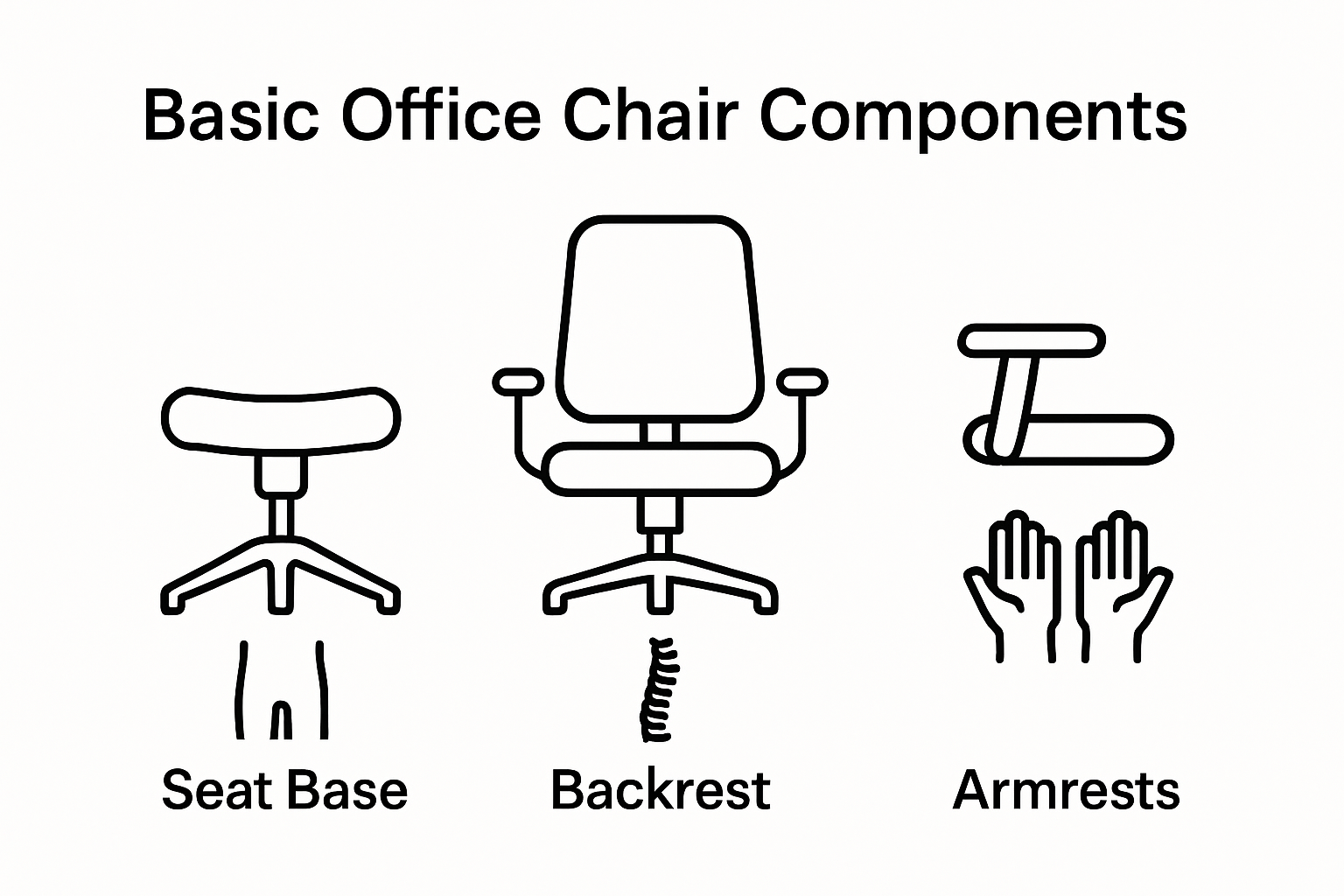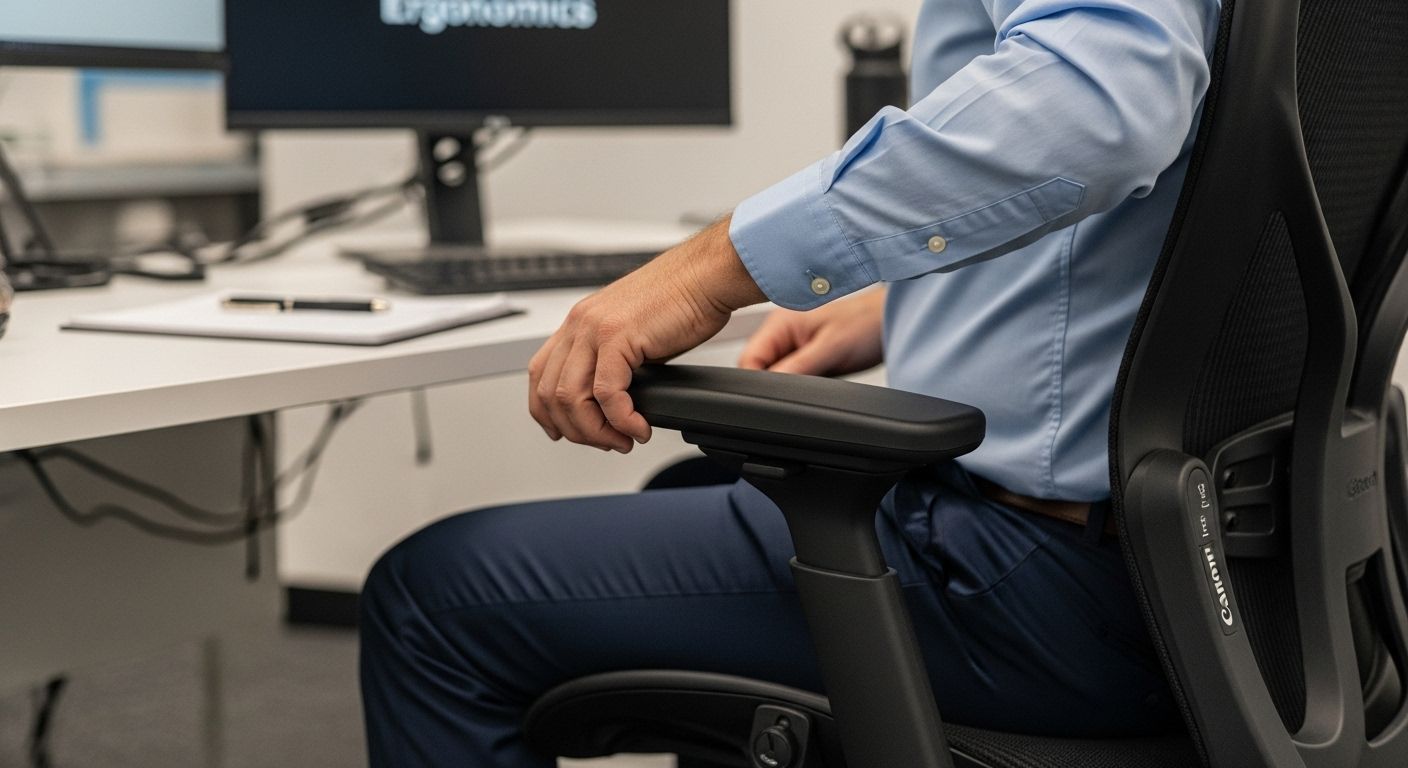Understanding the Components of Office Chairs
25th Aug 2025
Understanding the Components of Office Chairs
Most people see an office chair as just another piece of furniture in the office. Surprisingly, ergonomically designed chairs can reduce musculoskeletal problems by up to 61 percent and decrease lost workdays by 88 percent. It turns out that the smallest parts of a chair—the height adjustment, the tilt mechanism, even the type of foam—can quietly decide whether you leave work feeling strong or completely knackered.

Table of Contents
- Defining Office Chairs: Key Components Explained
- The Importance of Ergonomics in Office Chairs
- How Office Chair Components Influence Comfort and Health
- Material and Design Choices: Understanding Your Options
Quick Summary
| Takeaway | Explanation |
|---|---|
| Proper adjustability is essential. | Office chairs must accommodate different body types to ensure comfort and support. |
| Lumbar support prevents injury. | Adequate lumbar support maintains spinal alignment and reduces long-term musculoskeletal issues. |
| Dynamic movement enhances comfort. | Features like tilt mechanisms promote natural movement and decrease muscle stiffness during prolonged sitting. |
| Materials affect performance quality. | Selection of chair materials impacts durability, comfort, and ergonomic performance, influencing overall user experience. |
| Ergonomics boost productivity. | Ergonomic chairs can improve workplace health and reduce lost workdays by minimizing discomfort and strain. |
Defining Office Chairs: Key Components Explained
Office chairs are far more complex than simple seating solutions. At Bum Seating, we understand that each chair represents a sophisticated system of interconnected components designed to support human anatomy and enhance workplace productivity. Explore our comprehensive chair design guide to appreciate the intricate engineering behind modern office seating.
The Fundamental Structure of Office Chairs
Every office chair comprises several critical components that work together to provide comfort, support, and functionality. These core elements include the base, seat mechanism, seat cushion, backrest, and armrests. Each component plays a unique role in creating an ergonomic seating experience that adapts to individual user needs.
To help you quickly identify the main components of an office chair and understand their specific functions, here is a breakdown of each element and its primary purpose:
| Component | Function |
|---|---|
| Base | Provides stability and mobility, often with castors for easy movement |
| Seat Mechanism | Allows height, tilt, and sometimes seat depth adjustment |
| Seat Cushion | Offers comfort and weight distribution to support long working hours |
| Backrest | Supports the spine, especially the lumbar region, to maintain posture |
| Armrests | Reduces strain on shoulders and arms; often height and angle adjustable |

According to research from the National Institute for Occupational Safety and Health, proper chair design significantly impacts workplace health and employee productivity. The key considerations include:
- Adjustability to accommodate different body types
- Proper lumbar support to maintain spinal alignment
- Mechanisms that allow dynamic movement
Ergonomic Considerations in Chair Design
Ergonomic office chairs go beyond basic functionality. They are engineered to support the human body’s natural movements, reducing strain and preventing long-term musculoskeletal issues. The interaction between chair components determines overall comfort and health benefits.
Designers meticulously consider factors like seat depth, height adjustment ranges, tilt mechanisms, and weight distribution. These elements ensure that users can maintain proper posture throughout extended work periods, minimizing physical stress and potential workplace-related injuries.
The following table summarises the key ergonomic design principles discussed in the article, their purpose, and the resulting user benefit. Use this table to understand how each principle contributes to a healthier and more productive office environment:
| Ergonomic Principle | Purpose | User Benefit |
|---|---|---|
| Support for spine curvature | Maintains natural S-shape of the spine | Reduces back pain |
| Dynamic sitting postures | Encourages micro-movements and flexibility | Prevents muscle stiffness |
| Physical strain reduction | Minimises stress on muscles and joints | Lowers risk of long-term injury |
| Adjustable features | Adapts to different body shapes and sizes | Ensures individual comfort |
Understanding these components helps professionals and individuals make informed decisions when selecting office chairs that provide optimal support and comfort.
The Importance of Ergonomics in Office Chairs
Ergonomics represents a critical scientific discipline that transforms how we understand workplace comfort and health. At Bum Seating, we recognize that ergonomic office chairs are not luxury items but essential tools for maintaining employee wellbeing. Learn more about optimizing workspace seating to understand the profound impact of proper chair design.
Understanding Ergonomic Design Principles
Ergonomic office chairs are meticulously engineered to align with human body mechanics. According to research from the Chartered Institute of Ergonomics & Human Factors, effective ergonomic interventions can potentially reduce musculoskeletal problems by an impressive 61% and decrease lost workdays by 88%.
The core principles of ergonomic chair design focus on several critical aspects:
- Supporting natural spine curvature
- Promoting dynamic sitting postures
- Reducing physical strain during prolonged seated periods
- Accommodating diverse body types and sizes
Health and Productivity Implications
Beyond comfort, ergonomic chairs directly impact workplace productivity and employee health. Poorly designed chairs can lead to numerous physical complications, including chronic back pain, neck strain, and repetitive stress injuries. These conditions not only affect individual employee performance but can also result in significant long-term healthcare costs for organizations.
Modern ergonomic chairs integrate advanced features like adjustable lumbar support, dynamic tilt mechanisms, and customizable seat dimensions. These innovations enable workers to maintain optimal posture, reduce physical stress, and sustain higher levels of concentration throughout their workday.
By investing in ergonomically designed office chairs, businesses demonstrate a commitment to employee health, potentially reducing workplace injuries, improving overall job satisfaction, and creating a more supportive work environment.
How Office Chair Components Influence Comfort and Health
Every office chair is a complex ecosystem of interconnected components designed to support human physiology and enhance workplace wellness. At Bum Seating, we understand that chair design goes far beyond aesthetic considerations. Discover the secrets of optimal seating design to understand how each component contributes to user comfort and health.
Critical Components and Their Physical Impact
According to research in the International Journal of Industrial Ergonomics, specific chair components play crucial roles in preventing musculoskeletal disorders and maintaining physical wellbeing. The most significant components include:
- Lumbar support structures
- Seat height adjustment mechanisms
- Seat pan depth and width
- Dynamic tilt and recline features
- Weight distribution platforms
Each component serves a specific biomechanical purpose. The lumbar support, for instance, maintains the spine’s natural curvature, preventing excessive strain during prolonged sitting. Seat height and depth adjustments ensure proper leg positioning, reducing circulation impediments and muscular fatigue.
Biomechanical Interactions and Health Outcomes
Ergonomic chair design is fundamentally about understanding human movement patterns. Modern chairs integrate advanced engineering principles that allow dynamic sitting, enabling micro-movements that prevent muscle stiffness and joint compression.
The interaction between components like the backrest, seat mechanism, and armrests determines how effectively a chair can distribute body weight, support natural postures, and minimize physical stress. Chairs with synchronized tilt mechanisms, for example, allow the seat and backrest to move in concert with the user’s body, promoting more natural and less restrictive sitting experiences.
By carefully considering how individual components work together, manufacturers can create chairs that not only provide comfort but actively contribute to users’ long-term physical health and workplace productivity.
Material and Design Choices: Understanding Your Options
Office chair design is a sophisticated blend of scientific engineering and aesthetic innovation. At Bum Seating, we recognize that material selection and design choices are critical in creating chairs that transcend mere functionality. Explore our comprehensive chair selection guide to understand the nuanced world of chair design.
Materials that Define Performance
According to research from the National Institutes of Health, chair materials play a fundamental role in determining comfort, durability, and ergonomic performance. The primary materials used in modern office chair construction include:
- High-density polyurethane foam for seat cushioning
- Breathable mesh fabrics for backrest support
- Aluminum and steel for structural frameworks
- High-grade plastics for flexible components
- Leather and synthetic leather for premium finishes
Each material brings unique properties to chair design. Mesh fabrics, for instance, offer superior ventilation and flexibility, while high-density foam provides consistent support and weight distribution.
This table highlights the main materials used in modern office chair construction alongside their performance impact, to assist you in understanding your options when selecting a chair:
| Material | Performance Impact |
|---|---|
| High-density foam | Consistent support and even weight distribution |
| Mesh fabric | Superior ventilation and flexible back support |
| Aluminium/Steel | Structural strength and increased durability |
| High-grade plastics | Flexibility for moveable parts and reduced chair weight |
| Leather/Synthetic | Premium finish and easy cleaning |
Design Considerations Beyond Aesthetics
Design is not just about visual appeal but about creating functional ecosystems that support human physiology. Modern office chairs integrate complex design principles that address biomechanical requirements.
Key design considerations include weight distribution mechanisms, adaptable support structures, and intuitive adjustment systems. Chairs must accommodate diverse body types, work environments, and individual ergonomic needs. A well-designed chair considers factors like seat depth, lumbar curvature, armrest positioning, and tilt mechanisms.
By meticulously selecting materials and implementing intelligent design strategies, manufacturers can create office chairs that not only look sophisticated but actively contribute to user comfort, health, and workplace productivity.

Experience Office Chairs That Truly Support You
If you have ever struggled with discomfort, poor posture or even lost productivity due to the wrong office chair, you are not alone. As you learned in our article, understanding the components of office chairs is key to finding real ergonomic comfort rather than accepting daily aches. At Bum Seating, we put these principles into every product we offer, ensuring that each chair supports your body and boosts workplace health just as the research recommends.

Why settle for seats that fail to offer adequate lumbar support, dynamic adjustment or quality materials? Now is the best time to explore our broad range of ergonomic, executive and draughtsman chairs designed with proven comfort in mind. Visit Bum Seating today to browse our latest offerings or detail-packed chair selection guide and see how the right components can change your workday. Shop now for improved comfort and elevate your workspace before the next workday begins.
Frequently Asked Questions
What are the key components of an office chair?
The key components of an office chair include the base, seat mechanism, seat cushion, backrest, and armrests. Each part plays a vital role in providing comfort and support during use.
How does ergonomic design benefit office chair users?
Ergonomic design in office chairs supports natural body movements, reduces strain, and helps prevent long-term musculoskeletal issues, leading to improved comfort and productivity.
What role does lumbar support play in an office chair?
Lumbar support is crucial for maintaining the natural curvature of the spine, preventing excessive strain during prolonged sitting, and promoting overall physical well-being.
How can I tell if an office chair is adjustable to fit my body?
To determine if an office chair is adjustable, look for features like adjustable seat height, seat depth, lumbar support, and armrest positioning. These adjustments help accommodate various body types and enhance comfort.
